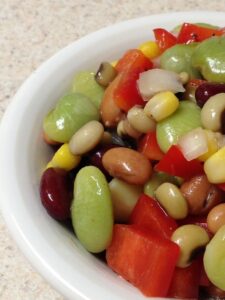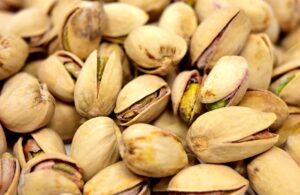by Dr Deborah Lee, Dr Fox Online Pharmacy

https://pixabay.com/users/soc7-752610/
If you’re looking for a new way to spruce up your diet – look no further. Fibre is the dieter’s friend. It’s easy to add fibre to your diet and has so many health benefits. Read on and find out more.
What is fibre?
Fibre is a type of indigestible carbohydrate – meaning it passes through your gastrointestinal tract unchanged. Even though you can’t digest it, it plays a major role in your gut health and your general health.
There are two types of fibre – insoluble and soluble. Insoluble fibre bulks out the intestinal contents, exerting pressure on the bowel wall, causing it to contract and relax, and helping move the partially digested food along. It is found mainly in plants, in the skins of fruit and vegetables, and unrefined grains such as wholegrain bread.
Soluble fibre is present in lentils, beans, and peas. It’s a gel-like substance that soaks up water, a bit like a sponge, and again bulks out the intestinal contents. Fibre is also important as it lowers the absorption of cholesterol through the gut wall.
In general, fibre intake is around 30% lower than the recommended intake. We should all be aiming to increase the fibre content of our diet by around 50%.
Why is fibre important in the diet?
Humans need enough fibre in their daily diet to stay healthy. Without fibre, the intestines function more slowly, leading to constipation, abdominal pain and bloating. Because it reduces cholesterol absorption, a low-fibre diet is linked to raised blood cholesterol levels.
Some medical conditions are associated with a low-fibre diet. These include constipation, irritable bowel syndrome, haemorrhoids, diverticulitis, heart disease, bowel cancer, breast cancer and obesity.
How does eating more fibre improve health?
People live longer – One meta-analysis of 7 prospective clinical trials concluded an 11% reduction in mortality with each additional 10g of fibre consumed per day. The authors attributed this to the well-established health benefits of eating more fibre.
Prevents heart disease – Various medical studies have shown a reduced risk of heart disease (heart attacks and strokes) in those with a high fibre consumption. A high fibre intake also reduces the risk of death in those with established heart disease. In one meta-analysis there was a 9% reduction in mortality for every additional 10g of fibre consumed.
Lower LDL cholesterol – Soluble fibre has been shown to lower LDL ‘bad’ cholesterol. An intake of 30g of fibre a day, can achieve an 18% reduction in LDL cholesterol. However, if you need to raise your HDL ‘good’ cholesterol or lower triglycerides, fibre is not likely to help. Nevertheless, studies show that increasing dietary fibre reduces heart disease and part of the reason why may be due to the cholesterol-lowering effect and a reduction in atherosclerosis.
Good for weight loss – Increasing fibre in your diet can help weight loss. Fibre helps you feel fuller for longer and help restrict calorie consumption. In fact, evidence to support high fibre diets and weight loss have generally only shown small improvements in weight loss. However, most of the studies are small, short term, and done on animals. A high fibre diet may well be especially beneficial for those who are overweight or obese and have metabolic syndrome, or type-2 diabetes, because of its benefits on blood glucose control, cholesterol and weight loss.
Improved blood sugar control – A high fibre diet helps improve blood glucose control. In one study of overweight or obese adults with metabolic syndrome, insulin sensitivity was 25% higher in the group on the high fibre diet, as compared to the other group on a high protein diet. In other studies, those with type 2 diabetes have been shown to have improved glucose levels, with favourable HbA1c, lipid levels and C-reactive protein – markers of chronic inflammation.
Prevention of bowel cancer – A high fibre diet is now widely accepted as protective for the development of colorectal cancer. It has been shown to reduce the risk of bowel cancer by as much as 20%. This may be because fibre helps food to transit through the intestines in a timely fashion, and regular bowel emptying prevents any faecal carcinogens from remaining for too long in contact with the bowel wall.
Improved gut microbiome – We now know that the health of your gut flora is the key to good health. The gut contains trillions of bacteria – known as the microbiome. These bacteria feed off the intestinal contents and produce by-products, which are important for our health. For example, short-chain fatty acids (SCFA’s), directly influence many body functions including regulating our appetite, controlling gut motility and enhancing insulin sensitivity. Fibre is needed as a substrate for these bacteria, and without enough fibre, the microbiome is disrupted.
Recovery from depression – Interestingly, there appears to be a link between a low fibre intake and depression. The SMILES trial concluded the greatest improvements in depression, were seen in the group treated with the Mediterranean Diet as opposed to the control group. This was felt to be because the gut microbiome affects mood via the gut-brain axis.
Daily fibre intake
The UK Dietetic Society recommend adults should have 30g of fibre per day.
Age 2 and over, children should have 15g per day. At primary school children should have 20g fibre per day, rising to 25 g per da at secondary school.
How to add more fibre to your diet

https://pixabay.com/users/alexas_fotos-686414/
Here are some high-fibre foods with a few tips on how to easily add them into your diet –
- 10-a day – Eat more fruit and vegetables – we are now recommended 10 portions a day. Eat them fresh with the skins on. Whole fruit contains far more fibre than just the juice, so don’t juice and throw the pulp away! Fruits especially high in fibre include berries such as raspberries, strawberries, and blueberries, kiwi fruit, mango, and avocado. Veggies – look for bright coloured ones such as broccoli, spinach, beetroot and sweet potatoes.
- Swap to Quorn or soya mince – Meat contains no fibre at all and is relatively high in saturated (bad) fat. If you swap to Quorn mince (which is a mycoprotein), or soya mince (from soya beans), these contain a healthy amount of fibre. Plus, eating less red meat is more environmentally friendly.
- Say ‘No’ to white foods – White foods included white bread, white rice and white pasta. These are white foods because they contain white flour, which is a refined – or processed – grain. During the milling process, the bran and the germ (the outer portion) of the grain have been removed to leave the endosperm (the inner grain) only. However, in brown, wholemeal flour, the grains are not refined, meaning it contains the whole grain, and are therefore rich in fibre. It’s quite simple to swap over and eat brown bread, brown rice and brown pasta instead.
- Eat jacket potatoes – Don’t underestimate the humble baked potato. A medium-sized baked potato contains about 5g of fibre. They are inexpensive, delicious and can be an easy way to make up your 30g a day.
- Nuts and seeds – Just a handful of chia seeds contains an incredible 9g of fibre! A tablespoon of flax seeds contains 2 g of fibre. These can be sprinkled onto yoghurt, or fruit, or added to smoothies, as another easy way to increase your fibre. Try adding pumpkin seeds, or sunflower seeds to salads, or sprinkling chopped nuts on desserts.
- Snack on fruit – Cakes and biscuits are processed foods. They contain large amounts of trans fats (solid fats) and sugar, and usually white sugar and flour. That’s why they are known as processed foods. It is far healthier to avoid processed foods.
Why not enjoy the natural, sweet goodness of a fresh pear than shovel down a cupcake? Try and get into the habit of filling up on fruit. You can still make sweet treats such as chocolate brownies, using healthy fats such as avocado, mixed with wholemeal flour, and adding in fruit such as prunes or dates.
- Nuts are good for you – All nuts are high in fibre. Snacking on nuts is better for you than you might think. Nuts are not only full of fibre, but they also contain healthy unsaturated fats. One portion of nuts – around 30 g – contains 2g of fibre. Don’t go for salted nuts however as these can raise your blood pressure. Nuts can also be added to cereal, yoghurt, or added to smoothies.
- Oat milk versus cow’s milk – Have you thought of swapping to plant milk? Each serving of oat milk contains 2g of fibre, whereas cow’s milk contains no fibre at all. Oat milk contains a soluble fibre known as beta-glucan which is known to lower LDL cholesterol.
- Eat cereal – Wheat bran and porridge oats are high in fibre. They can be found in bran flakes, wheat bisks, porridge, muesli and granola. An average portion of wheat bran cereal contains 9.8g of fibre, making this an excellent way to start the day, or even as a snack if you feel hungry. Take care not to go for a high sugar brand.
- Fibre supplements – You can try ispaghula husk or psyllium. Ispaghula husk is the powdered seed coat of the plant Plantago ovata Forssk. Psyllium is made from the powdered husk of a herb called Plantago psyllium. Both are very high in fibre. They can be taken as granules or powder, with meals, along with plenty of water. Speak to your pharmacist or your GP.
Final thoughts
Fibre is fantastic! Not only does it fill you up, stops you from feeling hungry and helps you lose weight, but it also makes sure your gastrointestinal tract functions properly and lowers your cholesterol. If there was one thing you could do to improve your health, it would be to add more fibre to your diet. And what’s more, high fibre foods are not expensive. You can do this by eating apples, bran flakes and baked potatoes!
- What could you do to add more fibre to your diet?
…………………………………………………………………………………………………………………………….